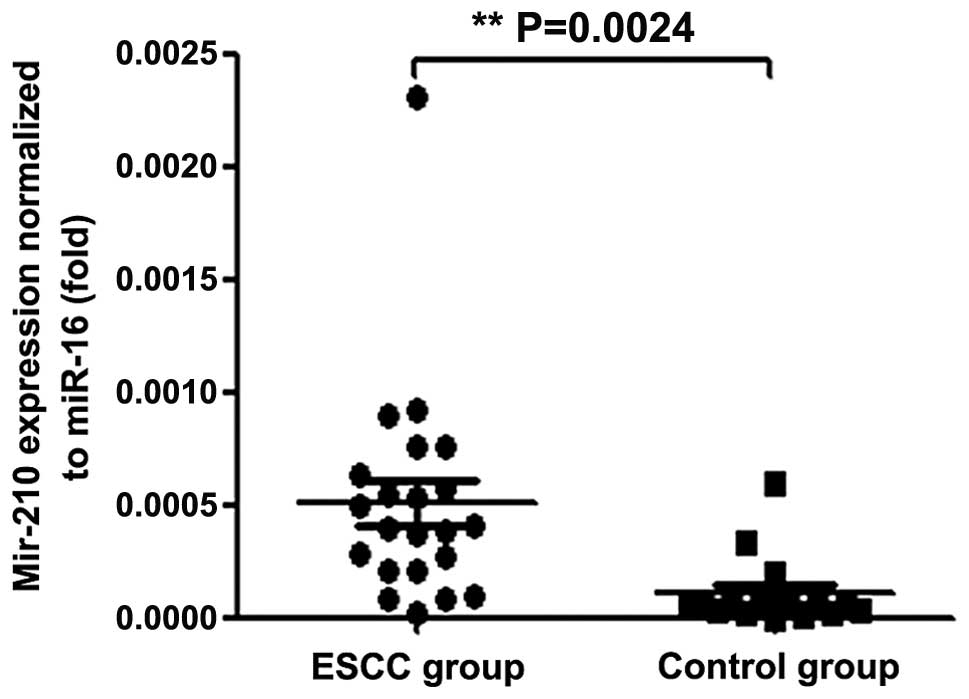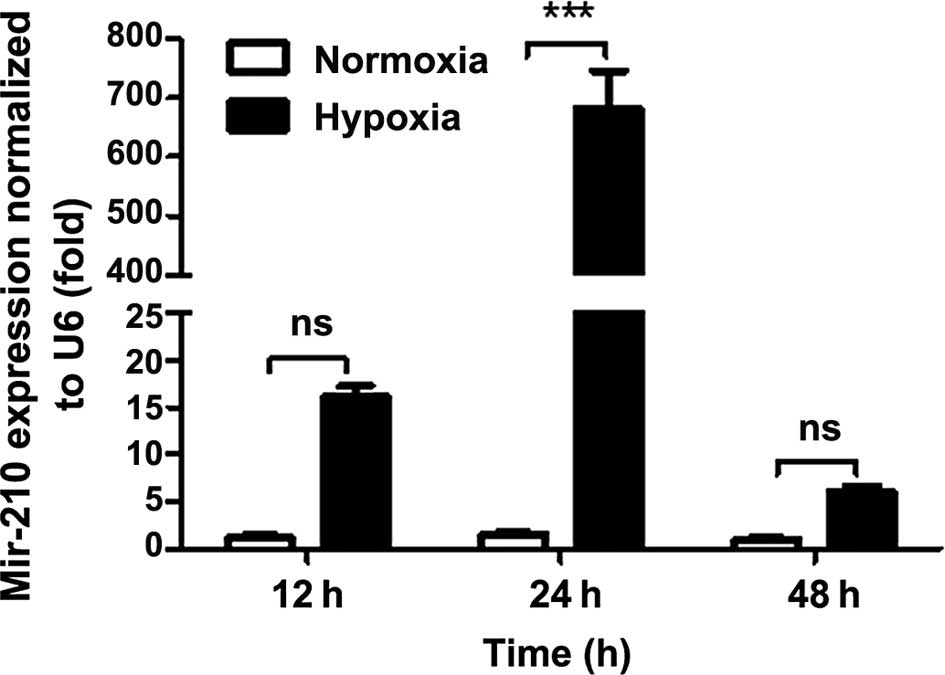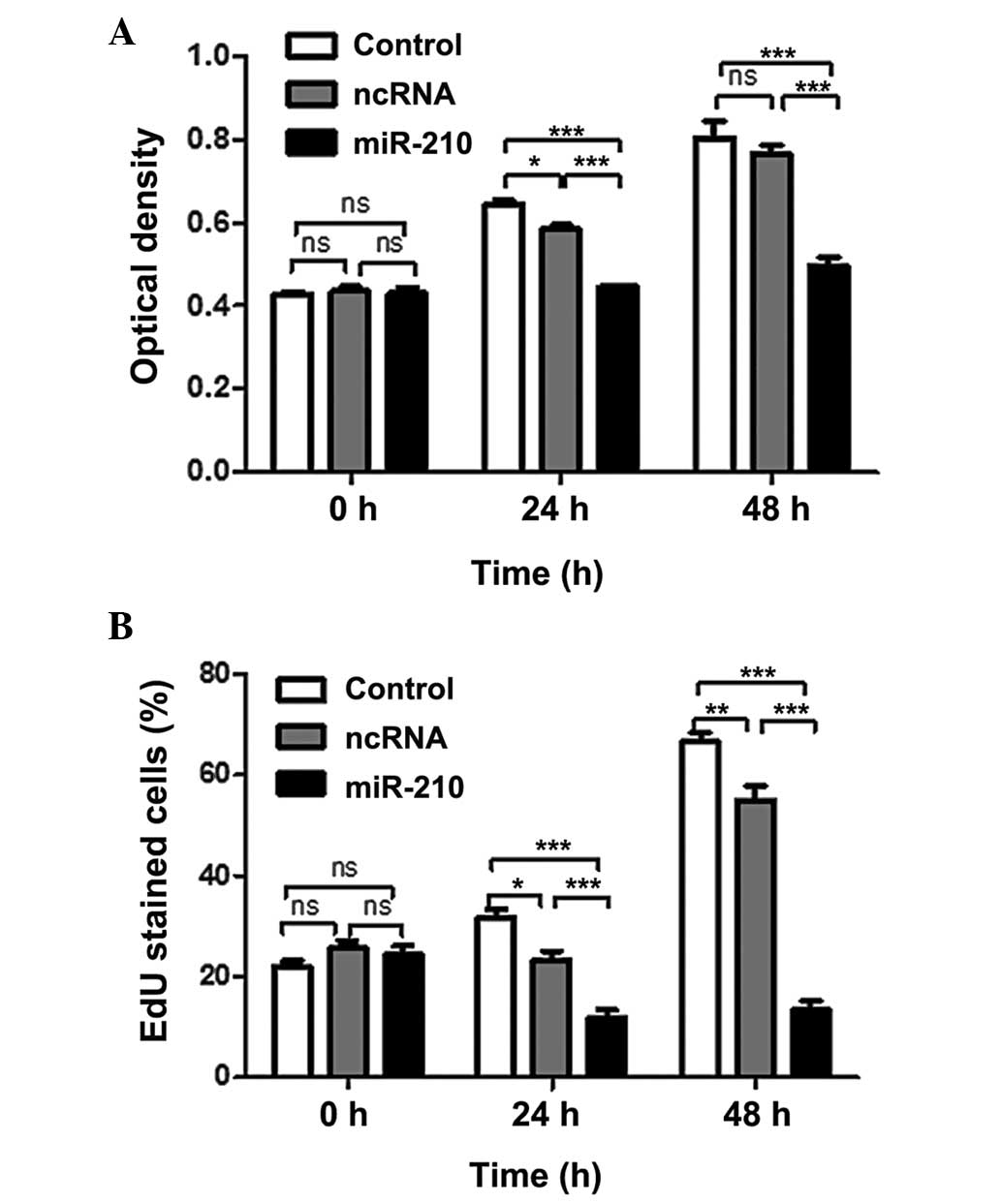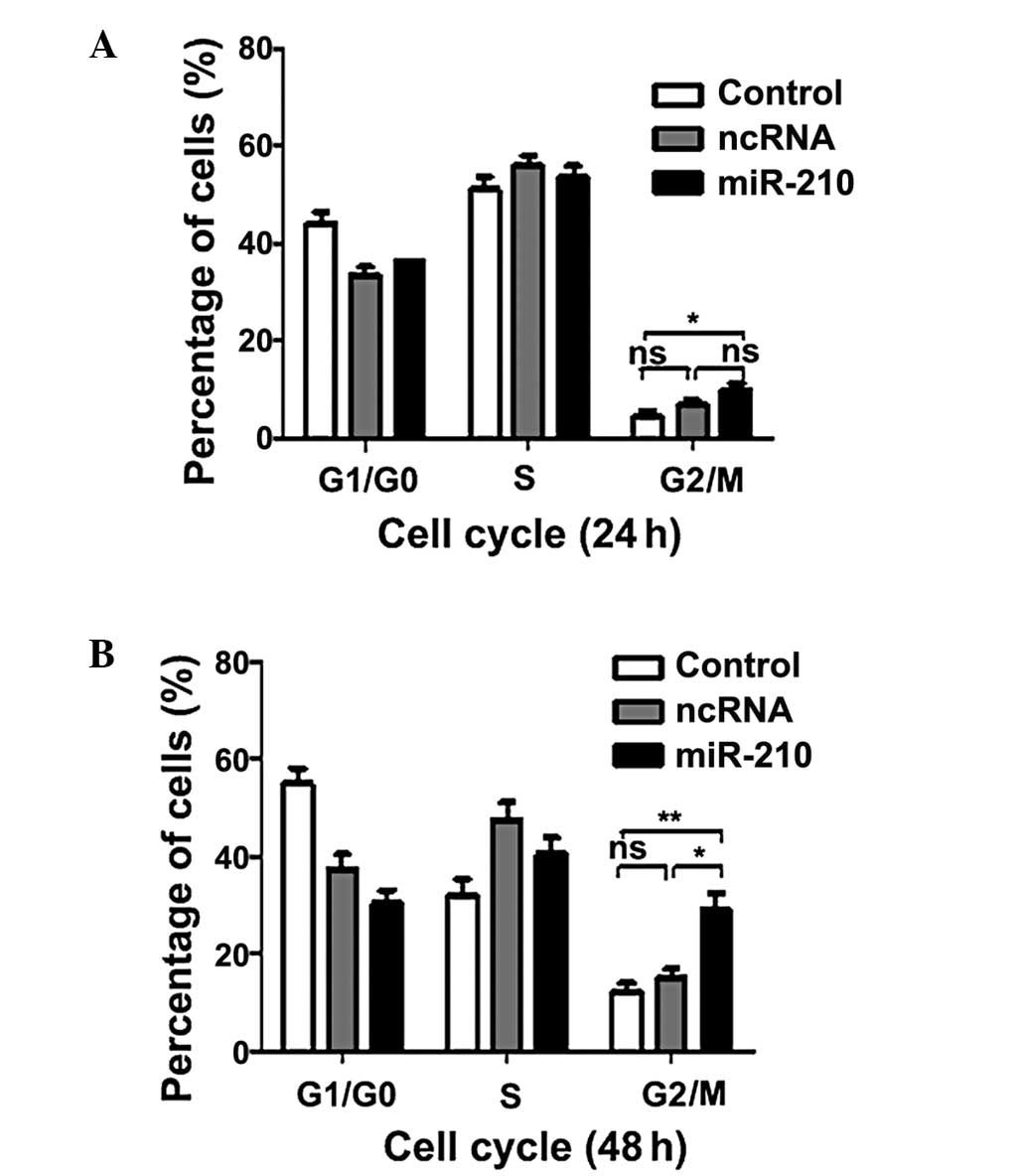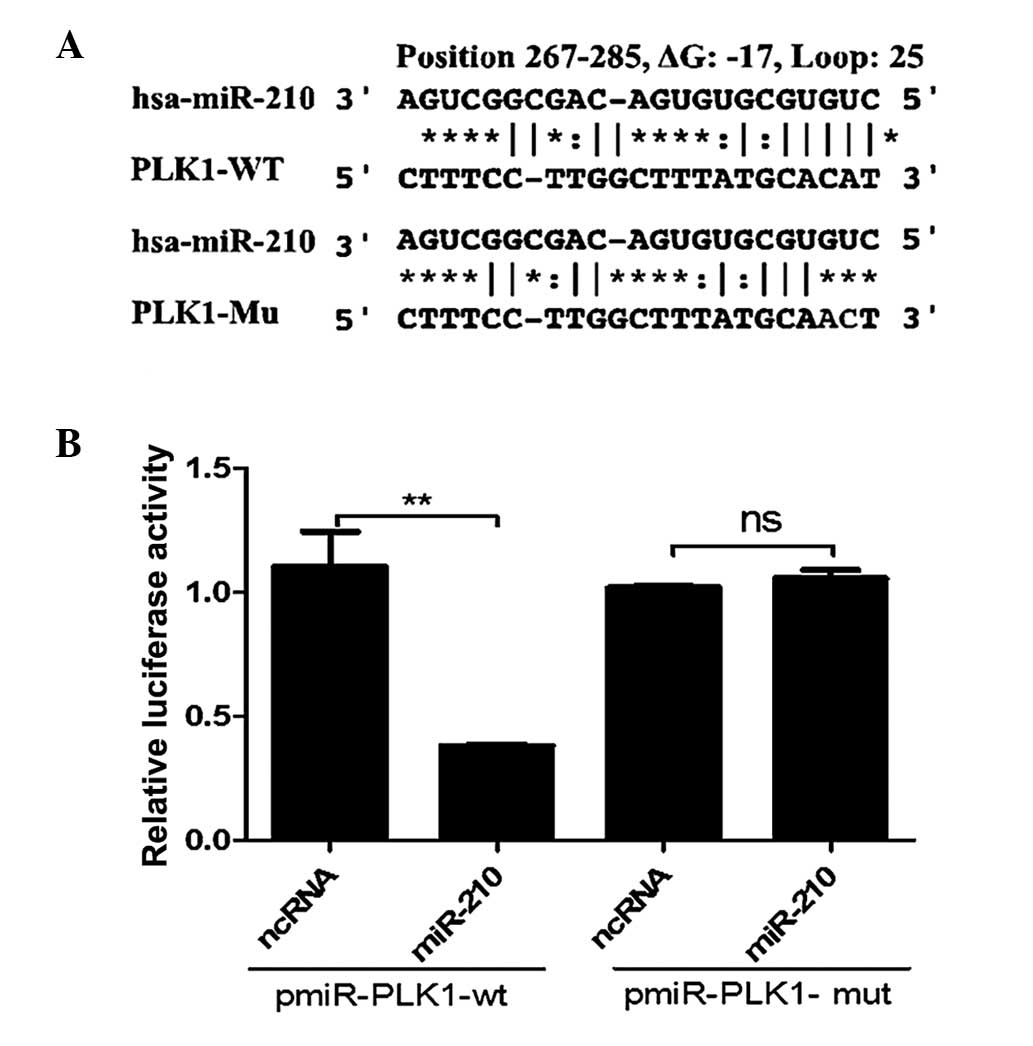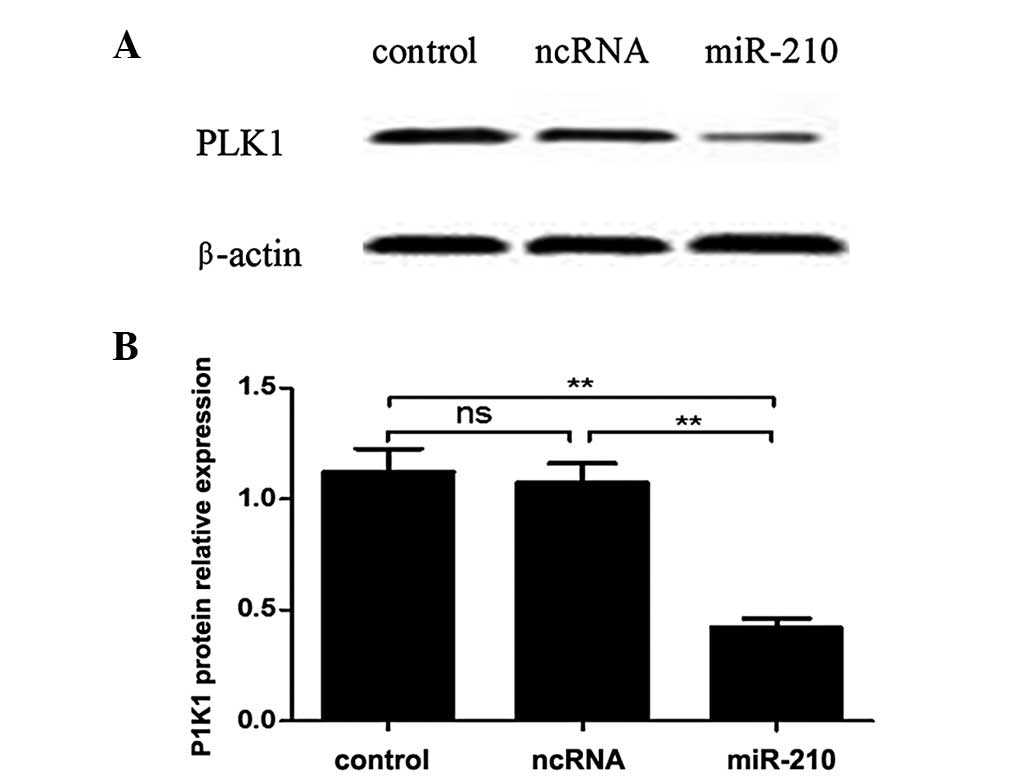miR‑210 regulates esophageal cancer cell proliferation by inducing G2/M phase cell cycle arrest through targeting PLK1
- Authors:
- Published online on: July 23, 2014 https://doi.org/10.3892/mmr.2014.2416
- Pages: 2099-2104
Abstract
Introduction
microRNAs (miRNAs) are a class of small non-coding RNAs that are 19–24 nucleotides in length, and crucial in various biological and pathological processes, including cell proliferation, differentiation, apoptosis, metabolism, organ morphology and angiogenesis (1,2). miRNAs primarily regulate gene expression through the inhibition of RNA translation by base pairing of their seed region (nucleotides 2–8) to the 30 untranslated regions of the target RNA (3). miRNA can also facilitate the targeting of specific mRNAs for cleavage, resulting in the downregulation of target mRNAs (4).
Intratumoral hypoxia is a hallmark of most solid tumors and results from increased oxygen consumption and/or insufficient blood supply. A number of the hypoxia-induced cellular responses are mediated through hypoxia-inducible factors (HIFs), which regulate genes involved in numerous functions, including angiogenesis, survival, cell metabolism and invasion. In a previous study, it was demonstrated that HIF-lα repressed esophageal squamous cell carcinoma (ESCC) growth in a murine xenograft mouse model (5). A number of miRNAs that are induced during hypoxia have been identified; one of these miRNAs (miR-210) is strongly induced by HIF-lα and has pleiotropic effects (6,7). It is reported that miR-210 inhibits proliferation in renal carcinoma, nasopharyngeal, pancreatic and head and neck cancer (8–10). Therefore, the present study hypothesized that miR-210, as a downstream target of HIF-1α, may be involved in cell survival in ESCC.
In the present study, the expression levels of circulating miR-210 were examined in patients with ESCC, and the induction of miR-210 in hypoxic ESCC cells was confirmed. The functional role of miR-210 in the growth of carcinomas and the mechanism by which it acts were also investigated.
Materials and methods
Patients and plasma samples
Approval from the Medical Ethics Committee of the Fourth Affiliated Hospital of Hebei Medical University (Shijiazhuang, China), and written informed consent from all participants were obtained prior to the start of the study. Subjects included 22 patients with newly diagnosed ESCC (no prior treatment) from the Fourth Affiliated Hospital of Hebei Medical University from September 2012 to May 2013, and 15 healthy volunteers. All patients with ESCC were treated with 58~64 Gy by 3D-conformal radiation therapy or intensity-modulated radiation therapy. Up to 8 ml of whole blood was obtained from each patient prior to radiotherapy, and from the healthy controls. Immediately subsequent to collection, the blood samples were subjected to isolation of cell-free nucleic acids using a 3-spin protocol (1,200 g for 30 min, 12,000 g for 5 min and 12,000 g for 5 min) to prevent contamination by cellular nucleic acids. Plasma samples were then stored at −80°C until further processing.
Cell culture and transfection
Eca-109 and HEK 293t/17 cells were obtained from Dr. BE Shan and YM Zhao (Department of Scientific Research Center, the Fourth Hospital of Hebei Medical University, Shijiazhuang, China). The cells were cultured in RPMI-1640/Dulbecco’s modified Eagle’s medium supplemented with 10% fetal bovine serum, 100 U/ml penicillin and 100 μg/ml streptomycin, were confirmed to be negative for Mycoplasma and maintained in a humidified 5% carbon dioxide (CO2) atmosphere at 37°C (all reagents were purchased from Gibco Life Technologies, Grand Island, NY, USA). Cells were maintained under hypoxic conditions in the presence of 1% oxygen using a hypoxia incubator (MiniGalaxy A, RS Biotech, Scotland, UK), using a continuous flow of a humidified mixture of 95% N2 and 5% CO2. The cells were transfected with oligoribonucleotides for miR-210 or negative control RNA (ncRNA; Ambion Life Technologies, Carlsbad, CA, USA) using HiPerFect Transfection Reagent (Qiagen, Valencia, CA, USA) according to the manufacturer’s instructions for overexpression.
RNA extraction and quantitative polymerase chain reaction (qPCR)
RNA was isolated from 400 μl serum sample and cells using the mirVana PARIS kit (Ambion). RNA quality and abundance were determined following extraction using a 2100 Bioanalyzer (Agilent Technologies, Santa Clara, CA, USA) and a NanoDrop ND-1000 Spectrophotometer (Thermo Fisher Scientific, Wilmington, DE, USA), respectively. The expression of miR-210 was determined by qPCR using TaqMan MicroRNA Assay kits (Applied Biosystems Life Technologies, Carlsbad, CA, USA). For synthesis of cDNA, 10 ng of total RNA for each serum sample was used for the individual assays in a 15 μl reaction mixture containing 5 μl RNA extract, 0.15 μl deoxyribonucleotide triphosphate (100 mM), 1 μl MultiScribe reverse transcriptase (50 U/ml), 1.5 μl 10× reverse transcription buffer, 0.19 μl RNase inhibitor (20 U/ml), 1 μl gene-specific TaqMan primer and 4.16 μl nucleotide-free water. The reaction mixture was incubated at 16°C for 30 min, 42°C for 30 min and 85°C for 5 min. Subsequently, 5 μl DNA template was amplified using 10 μl 2× TaqMan PreAmp Master Mix (Applied Biosystems), 3 μl nuclear-free water, and 2 μl gene-specific TaqMan primers/probe mix in a final volume of 20 μl. qPCR was run on the 7500 Fast Real-Time PCR system (Applied Biosystems). The reaction mixture was incubated at 95°C for 5 min, followed by 40 cycles of 95°C for 10 sec, 60°C for 30 sec and 72°C for 1 sec. TaqMan qPCR was performed in triplicate. The qPCR data were normalized to endogenous control genes that were ideally stably expressed across the analyzed samples to reduce measurement errors.
Assay of cell proliferation and cell cycle
Cell counting kit (CCK)-8 and flow cytometric assays were used to measure cell proliferation and analyze the cell cycle distribution, respectively. These procedures were conducted with Eca-109 cells at 24 and 48 h subsequent to transfection, as described above. The bromodeoxyuridine (EdU) incorporation assay, which measures cell proliferation, was performed using the EdU in vitro Imaging kit (Guangzhou RiboBio Co., Ltd., Guangzhou, China) according to the manufacturer’s instructions. Calculations for the analysis of the cell cycle were performed with ModFit software 2.0 (BD Biosciences, Franklin Lakes, NJ, USA).
Dual-luciferase reporter assay
The region of human polo-like kinase PLK1–3′ untranslated region (UTR), generated by PCR amplification, was cloned into the pmiR-RB-REPORT luciferase reporter gene plasmid vector (Guangzhou RiboBio). The primer sequences were as follows: h-PLK1-wild-type (wt), forward 5′-CCGCTCGAGTAGCTGCCCTCCCCTCCGG-3′ and reverse 5′-GAATGCGGCCGCCTGGCACCCCTCAGGAAATACAAG-3′; h-PLK1-mutated (mut), forward 5′-TTGGCTTGTGCGTGTTTAAACAGATGTGAATATTC-3′ and reverse 5′-TGTTTAAACACGCACAAGCCAAGGAAAGGACAG-3′. These constructs were named pmiR-PLK1-wt and pmiR-PLK1-mut. For the reporter assay, HEK 293t/17 cells were seeded onto 24-well plates and transfected with 500 ng of pmiR-PLK1-wt or pmiR-PLK1-mut and 100 nM miR-210 mimics or ncRNA using lipofectamine 2000 (Invitrogen Life Technologies, Carlsbad, CA, USA). Following transfection for 48 h, cells were harvested and assayed with the Dual-Luciferase Reporter Assay system (Promega, Madison, WI, USA) according to the manufacturer’s instructions. The tests were performed in triplicate.
Western blot analysis
Transfected cells were harvested for immunoblot analysis after 48-h incubation. Cells were lysed in Lysis Buffer (Beyotime Institute of Biotechnology, Jiangsu, China), and protein concentrations were measured using the Bicinchoninic Acid Protein Assay kit (Beyotime Institute of Biotechnology). Total protein was separated by SDS-PAGE using a 12% polyacrylamide gel and electroblotted onto a polyvinylidenefluoride membrane (EMD Millipore, Billerica, MA, USA). The membrane was immunoblotted overnight at 4°C with the following primary antibodies: Rabbit monoclonal antibody against human PLK1 (1:500; Cell Signaling Technology, Inc., Danvers, MA, USA) and mouse monoclonal antibody against human β-actin (1:2,000; Beyotime Institute of Biotechnology). A secondary antibody, horseradish peroxidase-conjugated goat immunoglobulin G (1:1,000; Beyotime Institute of Biotechnology), was incubated with the membrane for 1 h following three washes with Tris-buffered saline with Tween 20. Signals were detected with UltraECL Western Blot Detection reagent (Beyotime Institute of Biotechnology). The images were obtained on Kodak film (Rochester, NY, USA) and quantified with Quantity One software 4.4 (Bio-Rad Laboratories, Hercules, CA, USA). All experiments were performed in triplicate.
Statistical analysis
All data were calculated as the mean ± standard deviation. SPSS version 18.0 (SPSS, Inc., Chicago, IL, USA) was used for statistical analysis. Comparisons between treatment groups and controls were conducted with Student’s t-test. P<0.05 was considered to indicate a statistically significant difference.
Results
Circulating miR-210 overexpression in esophageal cancer
A total of 37 participants were involved in the present study, including 22 patients with ESCC and 15 healthy individuals. The clinicopathological characteristics of the study population are summarized in Table I. The ranges of the Ct values of miR-210 in the ESCC and control groups were 22.8–34.7 and 23.6–37.5, respectively. Fig. 1 presents the ΔCt values obtained from the two groups. The miR-210 serum concentration was elevated in the ESCC group compared with the control group. No significant association was found between miR-210 levels and gender, age, tumor location and differentiation levels (Table I).
miR-210 is induced by hypoxia
To assess whether hypoxia regulates miR-210 expression in ESCC, Eca-109 cells were exposed to 1% oxygen for different time periods. Among the different settings, the hypoxia-induced miR-210 expression was discernible following 24 h (Fig. 2).
miR-210 inhibits cancer cell proliferation by inducing cell cycle arrest in G2/M phase
The functional role of miR-210 in ESCC was assessed by adding synthetic miR-210 to the Eca-109 cell line, in which miR-210 expression is low (Fig. 2). The effect of miR-210 on the proliferation of ESCC cells was examined by CCK-8 assay. Transfection of miR-210 significantly reduced the proliferation rate of cancer cells (Fig. 3A). In addition, an EdU incorporation assay was performed, and the results indicated that miR-210 significantly reduced the uptake of EdU (Fig. 3B). These results suggested that miR-210 negatively regulated cancer cell proliferation. Following this, the effect of miR-210 on the cell cycle was investigated. As shown in Fig. 4, transfection of miR-210 resulted in a significant increase the G2/M phase population. The results suggested that miR-210 may inhibit proliferation of ESCC cells inducing G2/M phase arrest.
miR-210 targets the PLK1 3′-UTR directly
To explore the underlying mechanism of the association between miR-210 expression and cell cycle arrest, the FindTar3 algorithm (http://bio.sz.tsinghua.edu.cn/) was used to identify targets of miR-210, taking into consideration whether the predicted genes are likely to be potential candidates linked to the cell cycle. One of the common targets identified by the program was PLK1, which is critical during G2/M transitions of the normal cell cycle. To validate the target prediction, the direct interaction between miR-210 and the 3′UTR of PLK1 mRNA was assessed. As presented in Fig. 5, when miR-210 oligos were transfected into 293T/17 cells with the reporter construct pGL3-Luc-PLK1, luciferase activity was reduced by >50% compared with the activity following transfection with scramble oligos.
miR-210 represses expression of PLK1
The present study demonstrated that miR-210 targets the PLK1 3′UTR directly. In order to further explore the association between miR-210 and PLK1, protein expression levels of PLK1 in human esophageal squamous cells were assessed by western blotting. As presented in Fig. 6, the levels of PLK1 protein expression in transfected cells with miR-210 oligos were significantly reduced compared with the expression in cells with stable integration of the scramble sequence after 48 h.
Discussion
miR-210 is reportedly induced under hypoxic conditions and regulated by HIFs as a transcriptional target (11). The present study provided support for this in ESCC. In previous studies, altered expression of miR-210 was reported in other malignant tissues, including head and neck, pancreas, breast and ovarian cancer (10,12–15); however, the expression of circulating miR-210 has rarely been discussed. In the present study, it was demonstrated for the first time, to the best of our knowledge, that the expression of circulating miR-210 is upregulated in patients with ESCC. Another study on the role of circulating miRNAs in cancer and their potential utility as prognostic markers has emerged. The correlation of circulating miR-210 levels with breast cancer mortality rates is evident, according to a study by Jung et al (16), who reported that plasma miR-210 levels correlated with sensitivity to trastuzumab, tumor presence and lymph node metastases in patients with breast cancer. Another previous study indicated a statistically significant four-fold increase in circulating levels of miR-210 in patients with pancreatic cancer, compared with levels in normal controls (17). It must be taken into account that the above three studies were conducted on small cohorts, but the presence of elevated miR-210 in the plasma of patients with cancer suggests that this may be a vital factor to consider, and may further advance the understanding of the underlying pathogenesis of multiple types of cancer.
In order to enhance the understanding of the function of miR-210 in esophageal squamous cells, the consequences of miR-210 overexpression in Eca-109 squamous cells cultured under normoxic conditions were examined. The inhibition of proliferation implied by the CCK8 and EdU incorporation assay is consistent with previous similar studies in renal carcinoma and nasopharyngeal cancer cells (8,9). Additionally, overexpression of miR-210 in pancreatic and head and neck cancer cell lines has been demonstrated to delay tumor cell growth in a murine xenograft mouse model (10). Consistent with this observation, transfection of miR-210 was indicated to significantly induce G2/M phase cell cycle arrest. Several other studies have also demonstrated that miR-210 inhibited tumor cell proliferation by inducing G0/G1 and/or G2/M phase cell cycle arrest. In contrast with other solid tumors, miR-210 is frequently underexpressed in cases of ovarian cancer. This potentially leads to increased expression of the transcription factor E2F3, which participates in regulation of the cell cycle (14). Likewise, miR-210 is downregulated in ESCC. miR-210 inhibits cancer cell proliferation and induces G0/G1 phase cell cycle arrest by uninhibiting fibroblast growth factor receptor-like 1 (FGFRL1), which in turn accelerates cell cycle progression (15). However, it cannot generally be stated that miR-210 induction in hypoxia negatively regulates cell cycle progression and proliferation. In hepatic cancer cells, miR-210 activates the myc pathway via downregulation of the c-Myc antagonist MNT, and loss of myc has been demonstrated to abolish miR-210-mediated override of hypoxia-induced cell cycle arrest (18). Therefore, the net impact of miR-210 on cell cycle regulation may be context-dependent.
Clinical data also present this discrepancy. Marked reduction in the levels of miR-210 have been observed, particularly in poorly differentiated ESCCs (15). By contrast, overexpression of miR-210 in tumor tissues has been correlated with poor prognosis in breast, head and neck and pancreatic cancer (10,12,13,19). A likely explanation is that miR-210 is the most robustly induced miRNA under hypoxic conditions. It is possible that upregulated miR-210 expression levels only reflect the in vivo status of tumor hypoxia. However, given the well-established roles of tumor hypoxia in predicting a poor prognosis in patients with cancer, it is likely that the increased expression of miR-210 also correlates with the poor prognoses. Based on the evidence from the present and previous studies, it was hypothesized that miR-210 acts in the regulation of cell survival through multiple mechanisms, and further careful study of the function of miR-210 in different genetic backgrounds and human tumor types is required.
It is well-established that miR-210 induces G0/G1 phase cell cycle arrest by targeting E2F3 and FGFRL1. However, the underlying mechanism remains elusive. In the present study, PLK1, which is a critical regulator of mitosis at several levels, was investigated as a candidate target of miR-210. In the present study, it was demonstrated that miR-210 targeted the PLK1 3′UTR directly and suppressed its expression in Eca-109 squamous cells. Previous studies have demonstrated that PLK1 facilitates the activation of cyclin D kinase 1 (Cdk1)/cyclin B by activating cell division cycle 25C (Cdc25C) (20). The Cdc25 phosphatase family are essential in G2/M transitions of the normal cell cycle. Among them, Cdc25B and C are required for entry into mitosis (21,22). Activation of Cdk1/cyclin B is initiated by Cdc25B during the G2/M transition, while the full activation of Cdk1/cyclin B is governed by Cdc25C at the onset of mitosis. The active Cdk1/cyclin B then phosphorylates Cdc25B and C, resulting in an irreversible autoamplification loop that drives cells into mitosis (23). PLK1 also induces a further increase in Cdk1 activity by inhibiting Myt1 and inducing the degradation of Wee1 through phosphorylation (24,25). Aside from mitotic entry, PLK1 controls multiple processes during mitotic progression. PLK1 phosphorylates ninein-like protein and kizuna to promote the recruitment of g-tubulin ring complexes and keep the integrity of the centrosomes (25,26). PLK1 regulates sister chromatid resolution through promoting the removal of cohesins in prophase and promoting their cleavage by separase. PLK1 is also essential for cytokinesis as it activates the Rho guanosin triphosphatase, an activator of the actomyosin ring that encourages the contraction of the contractile ring and promotes cytokinesis (24). Together, these findings indicated that miR-210 may exert its tumor-suppressive effect in ESCC mainly by targeting PLK1. This conclusion was supported by a recent study demonstrating that miR-210 disturbs mitotic progression of nasopharyngeal cancer through regulating a group of mitosis-associated genes, including PLK1 (9).
In conclusion, the results of the present study was the first to reveal that circulating miR-210 levels were elevated in patients with ESCC and that it may potentially serve as a useful biomarker for ESCC diagnosis. miR-210 inhibits the proliferation of ESCC cells by inducing G2/M phase cell cycle arrest, and the effects of miR-210 are mediated mainly by the targeting of PLK1. The data suggested that miR-210 may be critical in the proliferation of ESCC and that miR-210 and its targets may serve as therapeutic targets of ESCC.
References
|
Krol J, Loedige I and Filipowicz W: The widespread regulation of microRNA biogenesis, function and decay. Nat Rev Genet. 11:597–610. 2010.PubMed/NCBI | |
|
Ambros V: The functions of animal microRNAs. Nature. 431:350–355. 2004. View Article : Google Scholar : PubMed/NCBI | |
|
Nilsen TW: Mechanisms of microRNA-mediated gene regulation in animal cells. Trends Genet. 23:243–249. 2007. View Article : Google Scholar : PubMed/NCBI | |
|
Lim LP, Lau NC, Garrett-Engele P, et al: Microarray analysis shows that some microRNAs downregulate large numbers of target mRNAs. Nature. 433:769–773. 2005. View Article : Google Scholar | |
|
Jing SW, Wang YD, Kuroda M, et al: HIF-1α contributes to hypoxia-induced invasion and metastasis of esophageal carcinoma via inhibiting E-cadherin and promoting MMP-2 expression. Acta Med Okayama. 66:399–407. 2012. | |
|
Hua Z, Lv Q, Ye W, et al: MiRNA-directed regulation of VEGF and other angiogenic factors under hypoxia. PLoS One. 1:e1162006. View Article : Google Scholar : PubMed/NCBI | |
|
Kulshreshtha R, Ferracin M, Wojcik SE, et al: A microRNA signature of hypoxia. Mol Cell Biol. 27:1859–1867. 2007. View Article : Google Scholar | |
|
Nakada C, Tsukamoto Y, Matsuura K, et al: Overexpression of miR-210, a downstream target of HIF1α, causes centrosome amplification in renal carcinoma cells. J Pathol. 224:280–288. 2011.PubMed/NCBI | |
|
He J, Wu J, Xu N, et al: MiR-210 disturbs mitotic progression through regulating a group of mitosis-related genes. Nucleic Acids Res. 41:498–508. 2013. View Article : Google Scholar : PubMed/NCBI | |
|
Huang X, Ding L, Bennewith KL, et al: Hypoxia-inducible mir-210 regulates normoxic gene expression involved in tumor initiation. Mol Cell. 35:856–867. 2009. View Article : Google Scholar : PubMed/NCBI | |
|
Huang X, Le QT and Giaccia AJ: MiR-210 - micromanager of the hypoxia pathway. Trends Mol Med. 16:230–237. 2010. View Article : Google Scholar : PubMed/NCBI | |
|
Gee HE, Camps C, Buffa FM, et al: hsa-mir-210 is a marker of tumor hypoxia and a prognostic factor in head and neck cancer. Cancer. 116:2148–2158. 2010.PubMed/NCBI | |
|
Camps C, Buffa FM, Colella S, et al: hsa-mir-210 is induced by hypoxia and is an independent prognostic factor in breast cancer. Clin Cancer Res. 14:1340–1348. 2008. View Article : Google Scholar : PubMed/NCBI | |
|
Giannakakis A, Sandaltzopoulos R, Greshock J, et al: miR-210 links hypoxia with cell cycle regulation and is deleted in human epithelial ovarian cancer. Cancer Biol Ther. 7:255–264. 2008. View Article : Google Scholar : PubMed/NCBI | |
|
Tsuchiya S, Fujiwara T, Sato F, et al: MicroRNA-210 regulates cancer cell proliferation through targeting fibroblast growth factor receptor-like 1 (FGFRL1). J Biol Chem. 286:420–428. 2011. View Article : Google Scholar : PubMed/NCBI | |
|
Jung EJ, Santarpia L, Kim J, et al: Plasma microRNA 210 levels correlate with sensitivity to trastuzumab and tumor presence in breast cancer patients. Cancer. 118:2603–2614. 2012. View Article : Google Scholar | |
|
Ho AS, Huang X, Cao H, et al: Circulating miR-210 as a novel hypoxia marker in pancreatic cancer. Transl Oncol. 3:109–113. 2010. View Article : Google Scholar : PubMed/NCBI | |
|
Zhang Z, Sun H, Dai H, et al: MicroRNA miR-210 modulates cellular response to hypoxia through the MYC antagonist MNT. Cell Cycle. 8:2756–2768. 2009. View Article : Google Scholar : PubMed/NCBI | |
|
Toyama T, Kondo N, Endo Y, et al: High expression of microRNA-210 is an independent factor indicating a poor prognosis in Japanese triple-negative breast cancer patients. Jpn J Clin Oncol. 42:256–263. 2012. View Article : Google Scholar : PubMed/NCBI | |
|
Donaldson MM, Tavares AA, Hagan IM, Nigg EA and Glover DM: The mitotic roles of Polo-like kinase. J Cell Sci. 114:2357–2358. 2001.PubMed/NCBI | |
|
Boutros R, Lobjois V and Ducommun B: CDC25 phosphatases in cancer cells: key players? Good targets? Nat Rev Cancer. 7:495–507. 2007. View Article : Google Scholar : PubMed/NCBI | |
|
Gabrielli BG, De Souza CP, Tonks ID, et al: Cytoplasmic accumulation of cdc25B phosphatase in mitosis triggers centrosomal microtubule nucleation in HeLa cells. J Cell Sci. 109:1081–1093. 1996. | |
|
Boutros R, Dozier C and Ducommun B: The when and wheres of CDC25 phosphatases. Curr Opin Cell Biol. 18:185–191. 2006. View Article : Google Scholar : PubMed/NCBI | |
|
Archambault V and Glover DM: Polo-like kinases: conservation and divergence in their functions and regulation. Nat Rev Mol Cell Biol. 10:265–275. 2009. View Article : Google Scholar : PubMed/NCBI | |
|
Lens SM, Voest EE and Medema RH: Shared and separate functions of polo-like kinases and aurora kinases in cancer. Nat Rev Cancer. 10:825–841. 2010. View Article : Google Scholar : PubMed/NCBI | |
|
Casenghi M, Meraldi P, Weinhart U, et al: Polo-like kinase 1 regulates Nlp, a centrosome protein involved in microtubule nucleation. Dev Cell. 5:113–125. 2003. View Article : Google Scholar : PubMed/NCBI |



